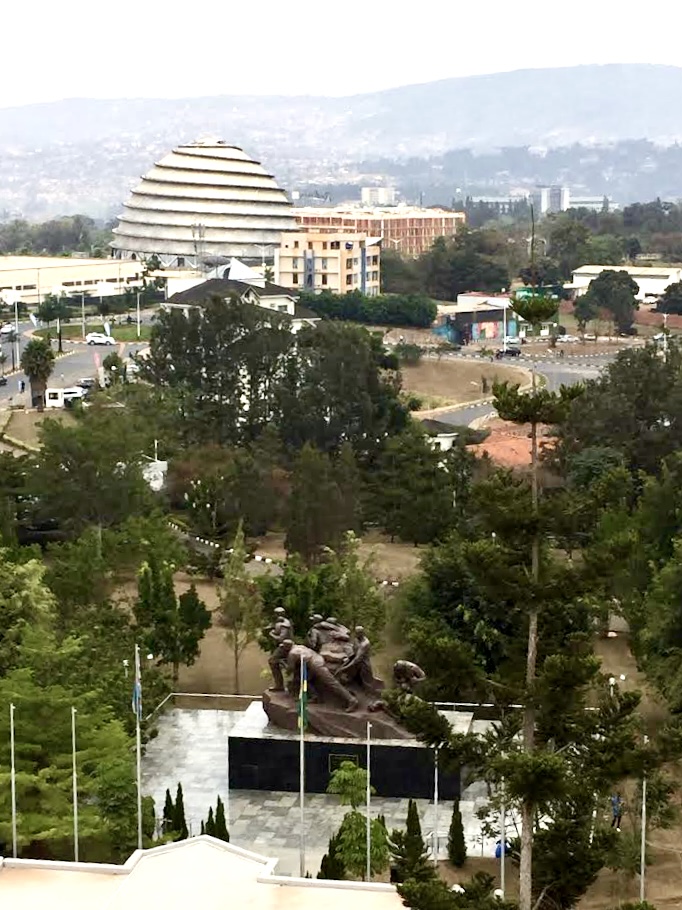The panorama of delightful Kigali, Rwanda’s capital city. Kigali is the safest African capital and clearly a beautiful city. Yet, the gleaming present belies a tortured past. The Genocide War Memorial in bottom foreground contrasts sharply with the new, eye-catching, beehive shaped convention center smack dab in the center of the picture.
Writer Zephyr Carlyle: What Am I Doing and Why is it Important?
November 2022. Background Information: Templesandtribes.net is a literary journal, however pretentious that may sound, and all contents from the fevered brain of me, Zephyr Carlyle. The journal entries range from travelogues, to historic narratives, to original short stories, to God forbid, my poems. Temples ‘n’ Tribes focuses on tribes (modern and ancient), archeological sites, and the aboriginal way of life — but also other topics of history and literature. As the sole content author, I just had fun writing some of these articles. Other articles were a real slog, the writing process was like a slow training lumbering into the station. Writing this Rwanda article was the worst; like a slow train lumbering through molasses as it enters the station. The problem is the focus of this story: a modern day genocide. The 1994 Rwandan genocide was a fast motion disaster (one hundred days and nights of pure terror) that unfolded in living color and dying color; all right in front of our collective eyes. I want to fast forward the topic from 1994 to 2022. My goal here is twofold: to give a current update on Rwanda’s recovery, and not allow this horror to be forgotten. Meeting these goals gives us a dividend: the unbridled celebration of Rwanda’s redemption and reconciliation.
Out of this nightmare comes a lesson. All the nasty conflicts in this world — whether big and bloody, or small and petty — can learn from the Rwanda experience. This tiny country, tucked away in a corner, and left to its own devices, transformed itself from a blood-orgy-nightmare into a bloomin’ rose.
This travelogue and historic tale is written differently from all the other journal entries in Temples ‘n’ Tribes. In all the other articles, I emphasize the travel and tour aspect of my journey. Here, I provide my personal story on this deep background of modern Rwanda history. This story is about Rwanda, but it is also a tale that speaks to the larger social conflicts ripping up our world. Conversely, it is about struggles in the smaller world that is our daily life. To provide the macro and micro view of this situation, I had to remove that veneer of impartiality that infects all my other journal articles. I usually write in that awkward third person. I include my experiences with phrasing like, ”This writer has never seen a ….” The voice used in this Rwanda article is not that third person perspective. No, this article is a full throated: “I was there and I saw ……” kind of viewpoint. The article uses the subjective “I” voice as I can not even pretend to be even-keeled or objective when writing about Rwanda. True, I did not witness first-hand the 1994 genocide. I do however, remember the horror as this three-month nightmare unspooled almost daily from television news into my U.S.A. living room. Twenty four years later, I went to Rwanda. What I saw and experienced in my 2018 Rwanda visit is seered into my permanent memory. I retraced the steps of the main conflict hot-spots, and bore witness whenever possible. I listened to survivors, paid homage at the memorials, and provided whatever support I could afford. Just the silence of the still destroyed buildings and graveyard markers stunned me into speechlessness. Together these are the testaments of the Rwanda struggles. The first was a life or death struggle just survive. Later came the monumental struggle to build a civil society that now thrives.
Rwanda got all sorts of world press during the ethnic slaughter. But when the killing stopped, the world moved on to the next shiny, shocking event, elsewhere. Nobody focused much, or frankly cared much, about inky dinky Rwanda. This article is the unheralded sequel to the 1994 blood bath. During the twenty plus years after the genocide ended, Rwanda got busy. Based on the black hole of news and my own ignorance, I expected Rwanda to be a nightmare, post-genocide rump of its former self. I was wrong. What I did not see in Rwanda amazed me as much as what I did see. I did not see broken-down people with a decrepit country to match. No. When I arrived and looked around, I was gob smacked, as the English say. Rwanda not only survived, but thrived.
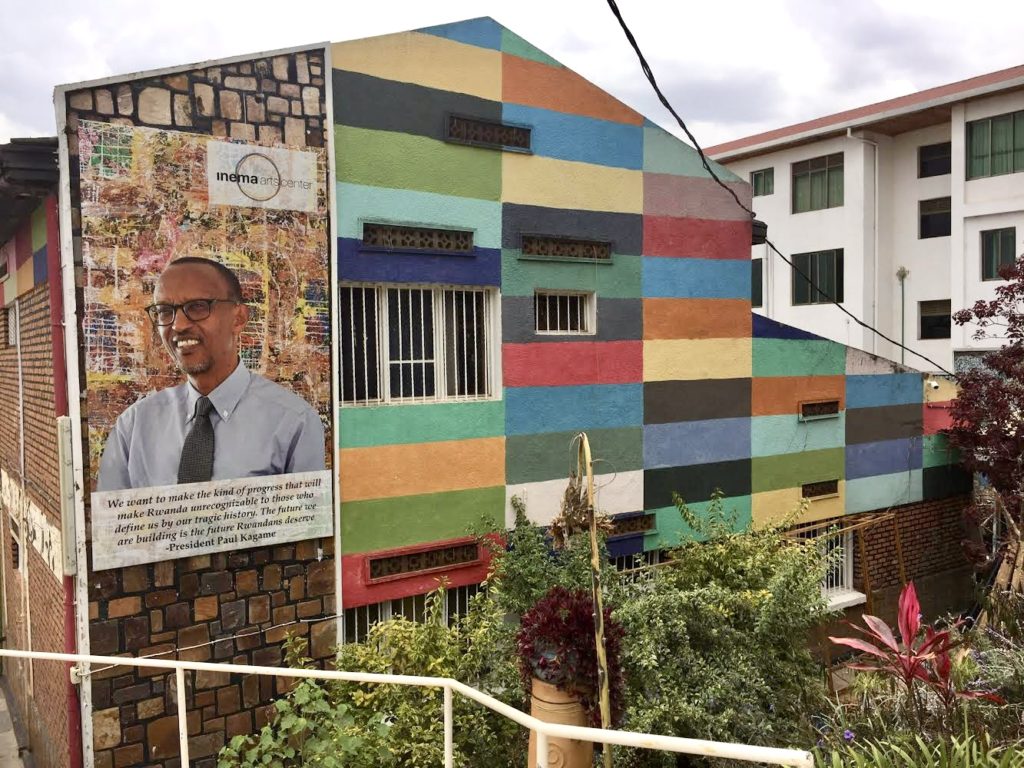
This country is on the move. Kigali, the capital city, is gleaming. Ignoring the few remaining destroyed buildings and some pock-marked neighborhoods, the rest of Rwanda is abuzz with activity. Rwanda is still on the mend, but it has come a long way baby. Left: The exterior of upscale Kigali art collective. This building houses exhibit galleries, community meeting space and a lovely cafe — all owned and operated by a local art non-profit. The Inema Art Center just one part of the vibrant Kigali art scene. The country is now thriving, while at the same time acknowledging a horrific past.
Tribes named ”Hutu” and ”Tutsi” Sound Almost Comical. Nothing Comical about Genocide and the Murder of 800,000 Innocent Rwandans
Rwanda is a small country, the size of Maryland, U.S.A. Rwanda borders on the Congo to the west and Tanzania to the east and also borders Uganda and Burundi. Before the genocide, about 85% of Rwanda’s population was Hutu; 14% were Tutsi, and 1% were Twa, also known as Pygmies. Human Rights Watch estimates that 77% of all Tutsis were killed in just one hundred days. [For a very interesting analysis of all demographics of Rwanda during this time, see: https://www.hrw.org/reports/1999/rwanda/Geno1-3-04.htm]
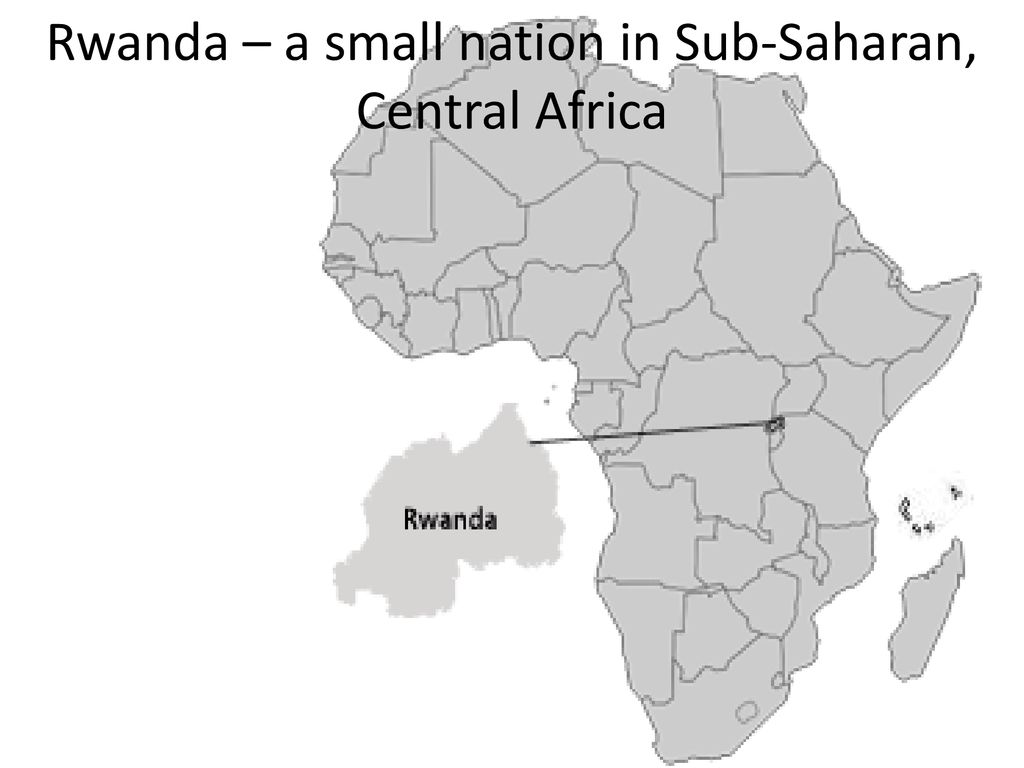
During the 1994 Rwandan genocide, members of the Hutu ethnic majority murdered as many as 800,000 people, mostly the Tutsi minority and Hutus tolerant of Tutsis. Starting in the capital city, Kigali, the genocide spread throughout the country with shocking speed and brutality. Ordinary citizens were incited by local officials and the Hutu Power Movement to take up arms and attack their neighbors. Many Hutus heeded the call and collectively slaughtered enormous numbers of Tutsis. For one hundred days, the Tutsis were hunted down and killed, mostly by machete or bare hands. The slaughter only stopped when the Tutsi-led militia army, the Rwanda Patriotic Front, defeated the murderous Rwanda government army and the Hutu militias. By the time the Rwanda Patriot Front (RPF) seized control, hundreds of thousands of Tutsis, and others, were dead. The Tutsi victory also precipitation two million refugees (mainly Hutus) to flee Rwanda for neighboring countries. The Hutus exited en masse fearing Tutsi reprisals. The two million refugees in neighboring, impoverished countries created one more full-blown humanitarian crisis. After the killing stopped, the Hutu fear and flight did point to the critical question: What would the Tutsis and the RPF do now that they were in control? The answer and its aftermath staggered the residents and the world: Build peace; recover together, and recover stronger.
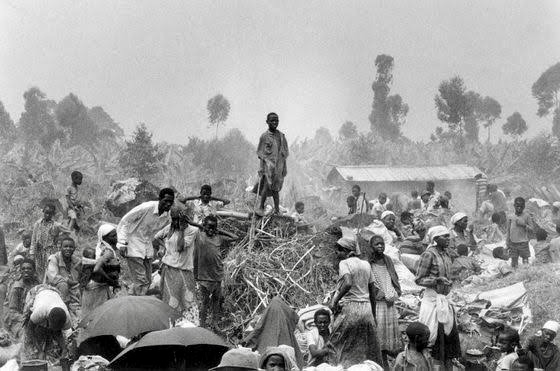
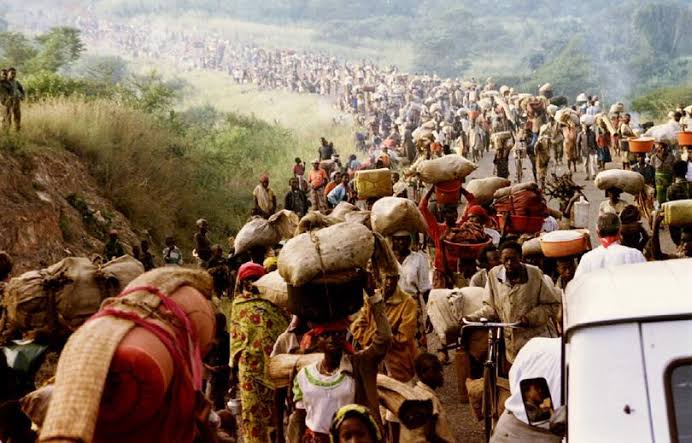
Rwandan Ethnic Tensions
Rwanda was first colonized by the Germans and made part of German East Africa from 1897 to 1918. Control of the Rwanda and neighboring Burundi colonies was transferred from Germany to Belgium after World War I. To subdue the natives, a ruthless, large-scale system of pitting of the Tutsis against Hutus started under the Germans and was supersized by the Belgians. This systemic oppression contrasted dramatically with the pre-colonial relations between Hutus and Tutsis. Historically, the Tutsi were dominant over the numerically superior Hutus, and that created flash conflict points,. However the tribes largely co-existed civilly and the relations between the two groups was fluid. Hutu and Tutsi rivalries sometimes spilled out into localized conflicts- more like gang warfare that flared up and then went away. However, Tutsis and Hutu largely lived and worked and loved together. There were tribal rivalry and resentments but NO blood feuds, rigid systemic abuse, nor large-scale mobilizations of combatants. This extreme polarization and enflamed ethnic hatred was started by the Germans; but perfected by the Belgians, all in order to divide and conquer.
In the almost forty years of Belgium rule, the Europeans favored the minority Tutsis over the majority Hutus. The traditional fluid dynamic between the tribes was replaced by intense hatred as Belgium fanned the flames of extreme bigotry. While remaining the colonial overlords, the Belgiums supported the Tutsis elite to run the local government and economy for themselves. This lopsided arrangement wildly benefitted the Tutsis. The Tutsi oppression limited Hutu living and denied them fair opportunities. To get this system to work, the Belgians had to install a rigid class and ideology system. The Belgium propaganda had echos of the Nazi ideology of a superior race that crushes inferior people. In the Rwanda context, it was the Tutsis as the naturally intelligent race who controlled the genetically and historically inferior Hutus. This discrimination was not subtle: this racial disparity was official government policy and promoted in state-run propaganda broadcasts. This racial profiling was picked up in the public media; in newspapers, radio, television, schools -everywhere. Thus, this malignant ideology was not passing propaganda. The hatred yielded discrimination that was evident in such things as education, jobs and housing allocations, property rights — and all favoring the Tutsis. The Hutus’ resentment festered and finally rose up to open warfare starting in the late 50’s. The 1959 Hutu Peasant Revolt resulted in the Belgians reallocating power to the Hutu majority at the expense of the Tutsis. However, the ethnic conflict just got worse from there. As a result of this Hutu uprising, hundreds of thousands of Tutsis fled to neighboring countries for safety. From these safe havens, the already existing Tutsi militia, the Rwandan Patriotic Front (RPF), became a full fledged guerrilla army under the command of Paul Kagame. From the safety of neighboring countries, the RPF fought small battles in the border areas of Rwanda but their goal at that time before 1994, was to regain Tutsi dominance. The simmering skirmishes between the RPF and the Hutu government festered for many years. In 1990, the RPF started a major invasion of Rawanda to regain control of the country. The fighting roiled Rwanda for several years. Ultimately, the U.N. sent in a small number of ineffective peace keepers. The combatants kept fighting. A small number of U.N. peacekeeping troops were already on ground when the genocide began. Their presence became a critical issue, or problem, for all parties: Hutu, Tutsi, United Nation and western governments. How would a small number of U.N. peacekeepers, and ultimately outside powers, respond when faced with widespread killing of the unarmed?

Racial categories were attached to major decisions, aided by a national identity card that labeled citizens by tribe. All of this racial tagging and disparities were used by the Belgians to divide the population and keep it subjugated. This strategy allowed a few (The Tutsis) to oppress the many (Hutus), creating a legacy of tension.
Rwandan Independence Did Not End Ethnic Conflict
Rwanda was granted independence in 1962 but the Hutu and Tutsi racial conflict continued and got even worse — including racially motivated political coups and a simmering civil war. The Rwanda government was nominally Hutu controlled but that did not satisfy Hutu extremists. By the mid-90’s, the Hutu Power Movement had their own shadow government and society — militias, racist self-help groups, youth organizations and the like. The extremists espoused a virulent Hutu-centered ideology demonizing the Tutsi and demanding extreme measures be taken against them.. This propaganda was broadcast far and wide by radio, television and the print media. However, it was the Hutu radio broadcasts that was most effective in poisoning the political atmosphere. The radio waves reached every corner of the country and was exploited to galvanize the Hutus and incite violence. At the same time, several of these extreme Hutu organizations clandestinely stockpiled machetes. The extremists also prepared for a violent uprising by linking up with sympathetic units of the armed forces, including those soldiers who controlled armories and military command centers. Hutu civilian militia training programs flourished. In sum, the step by step groundwork was being laid for the total destruction of the Tutsis.
In contrast, while the Hutu radicals were becoming more extreme, the Rwanda government came close to achieving social peace through moderation. The centrist Hutu president, Juvénal Habyarimana, wanted to share power between the Hutus and Tutsis, thus ending the existing civil war. In April 1994, Juvénal Habyarimana was flying back to Kigali after signing a power sharing agreement between moderate Hutu and Tutsi groups, including the pro-Tutsi army, the RPF. The agreement was the first and most significant step to end the long-simmering civil war. This bipartisan agreement laid the foundation for ethnic peace and allowed for the return of Tutsi refugees. Extreme Hutus rejected this deal in the most violent way. In the eyes of the ever expanding number Hutu extremists, Habyarimana was a traitor to the true cause of “Hutu Liberation.” To the Hutu rebels, the way to end the civil war was to kill every last Tutsi man, woman, and child. Genocide would solve the Tutsi problem.
As mentioned, in April of 1994, a plane carrying both Rwanda’s moderate Hutu leader Habyarimana, and Burundi’s moderate president, was shot down over the Rwanda capital city of Kigali. There were no survivors. Who shot down the plane is still a mystery. ُ ُThe main suspects are Hutu nationalists, but Tutsi extremist groups may not wanted to share power with the Hutus. Clearly, there is evidence that shooting the president’s plane out of the sky was the planned kick-off event to unleash the genocide. The plane crash was the perfect opportunity for a full-throated Hutu genocidal power grab. Within an hour of the plane crash, all the rebels — members of the Presidential Guard, elements of the Rwandan army, and Hutu militia groups — all set up road blocks and barricades to seal off Kigali. The genocide was spearheaded by the leading Hutu militia groups that had telling, but blood-chilling, names: Interahamwe (“Those Who Attack Together”); and Impuzamugambi (“Those Who Have the Same Goal”). All of these military and militia units swept the street clean of people and traffics. Then, they distributed their huge stockpiles of weapons, both the machete and the machine gun; okay, mostly machetes and some small firearms. Thus, began the slaughter of both the “Tutsi enemy” plus all Hutu moderates. The “Tutsi enemy” was every Tutsi man, woman and child. The extreme Hutus hacked, pummeled and shot all Tutsis to death. The Hutus killed their Tutsi friends, neighbors, shop owners, school teachers, elected officials bus drivers, and all others. The Hutu extremist also killed any known moderate Hutu such as any Tutsi-tolerant Hutu; and certainly any Hutu actively trying to hide or save any Tutsi. The most common weapons were machetes and bare hands.
In the Rwanda of that time, the radio was the most effective form of mass communication. For years, the drumbeat of ethnic hatred; plus, during the directives to slaughter during the genocide, were all broadcast far and wide on local radio. Below is a political cartoon showing how the word got around that to start the Hutu Liberation Uprising:
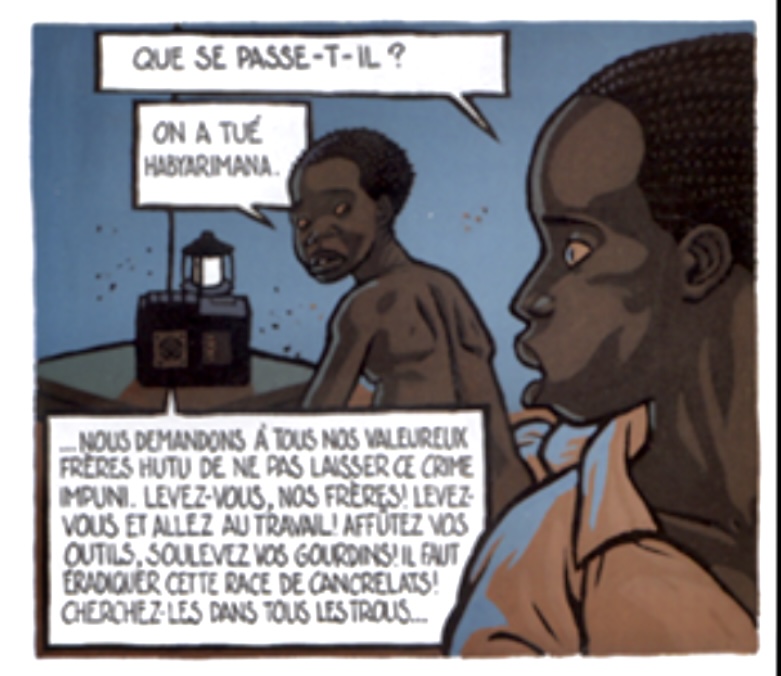
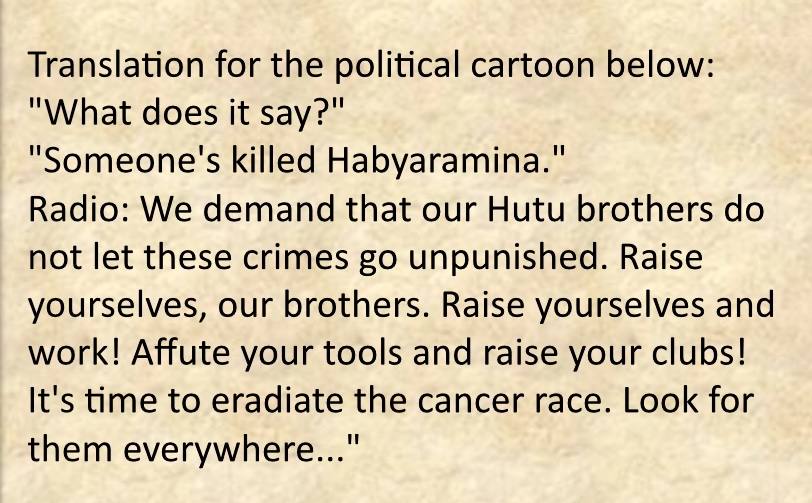
When I read stories of mass killings, the reality of the terrible deaths is somewhat abstract — horrifying, but emotionally distant. This separation of the individual experience from its effect on other people, was summed up by journalist and anti-war activist, Kurt Tucholsky, “The death of one man is a tragedy. The death of millions is a statistic.” However, when you walk the street with the victims who survived as they tell you their stories directly, then the abstract killings becomes an emotional, tragic reality that can not be ignored. I was in Rwanda in 2018, and the locals were willing to share their vivid memories of the slaughter. One Tutsi hotel clerk recounted his childhood memories of 1994. The Hutu militia went down the street stopping at each Tutsi home to kill those inside. The young boy and his family fled to their neighbors home, the home of their Hutu friends. Upon entering the house, their Hutu “friends” pulled out machetes and killed the family. The clerk survived as his dying relatives fell on top of him, allowing him to live. Another Hutu shared with me that his family was also slaughtered. The family crime? This Hutu had Tutsi in-laws that the Hutu clan accepted as members of their family. Needless to say, I cried hearing these stories. Note, this was a fluid massacre that was focused on exterminating Tutsis but encompassed some Hutus and others. Cynically, the Hutu deaths was an extreme form of colateral damage. There is a famous story that Hutu militiamen attacked a group of school children. The militiamen ordered the students to divide themselves by ethnicity—Hutus on one side, Tutsis on the other. The children refused to separate and thus identify the Tutsi students for death. So the militia killed them all — all Hutu, Tutsi, any others — all students. The students never cracked. No child pointed a finger at others to save himself. I would not have been that brave, if I were a kid in a similar situation. https://www.nationalgeographic.com/photography/article/revisiting-the-rwandan-genocide-hutu-or-tutsi
Rwanda Became a River of Blood and Wheelhouse of Destruction: Western Response? Leave!
In April 1994, a small number of U.N. peacekeeping troops were already in Rwanda. When the genocide started, the rebel Hutu military first targeted Prime Minister Agatha Uwillingiyimana, who was the next in line for the Rwanda Presidency. The Prime Minister was protected by fifteen peacekeepers — ten Belgium troops and five Ghanaians. Immediately after the President’s plane was shot down, the Hutu military took control of the Prime Minister for her own “safekeeping.” The rebels then brandished their arms and ordered the fifteen peacekeepers to stand down. The peacekeepers were transferred to a safe house under the guarantee that they and the Prime Minister would be protected. Naturally, the Prime Minister was immediately gunned down along with her husband. Their children escaped death by hiding in an adjoining compound. Meanwhile the Belgian and Ghanaian troops were taken to a safe house below. It was not safe. This safe house was the first memorial I visited. I was stunned by both the wanton deaths and their significance: the Hutus were declaring war on anyone who tried to interfere with their death machine. I cried at this house and also cried at several other memorials.
Jjj

The slaughter of the Belgium troops ended any hope of foreign intervention. This deliberate massacre of the Belgians broadcast to the world that the Hutu rebels would not respect the neutrality of anyone. All foreigners would be killed alongside the Tutsis and their local allies. Western intervention would require thousands of foreign fighters to enter Rwanda as combatants. How many foreign soldiers should die to stop a genocide that takes place within one sovereign country? The Western response: NONE. The remaining Belgian and other peacekeepers evacuated their home nationals out of Rwanda, with the peacekeepers leaving on the last flight out. The French actually did send in an additional four hundred and fifty peacekeepers. The fresh troops were there to simply protect French interests and escort French citizens back to France. The French troops left with their people. Thus, the Rwandans were on their own to live or die and about eight hundred thousand died.
The Embattled Tutsi Minority Rose Up to Stop the Slaughter. Their Leader was Paul Kagame
Beginning in 1990, Paul Kagame became the commander of the Rwandan Patriotic Front (RPF), the rebel army leading the struggle against Hutu domination. From 1990 to 1994 Kagame and the RPF, all based in neighboring countries, tried to liberate Rwanda from total Hutu control. After the genocide started, the mission focused up: The RPF had to stop the killing. No one, no country, no international organization, nobody else stepped up to help the RPF.
The RPF was one of the original signatory on 1994 power sharing agreement — the same agreement that was shot down along the moderate Rwanda president. In the genocide period, it was left to the RPF to rise up and stop the Tutsi slaughter. Kagame led a force of between ten and fourteen thousand RPF soldiers against the Hutu forces. The outnumbered RPF had to avoid direct assaults against the Hutu armies and use guerrilla warfare tactics on enemy strongholds. Kagame’s brilliant leadership kept RPF casualties to a minimize and allowed the RPF liberators to capture Kigali, in early July which ended the genocide. The genocide lasted about one hundred days – April to July, 1994. After much joyous celebration, the RPF set up a new government with a Hutu president. However, the real power rested with Kagame, who served as vice president and minister of defense. In 2000, Kagame was elected president of Rwanda’s transitional government by their National Assembly. Kagame has been the strong-man leader of Rwanda to this day.
The Tutsis of the RPF and Kagame Won: Now, What Comes Next?
Imagine the light headedness, or perhaps the brain throb, of Paul Kagame and the victorious RPF. What would you, as a victorious Tutsi leader, do to the Hutu perpetrators who murdered 800,000 people, including your friends, relatives and neighbors; people of your shared language and culture? And how do you do this if the perpetrators are innumerable members of a major ethnic group in a country that is a simmering pot of racial tension? Who are the criminal perpetrators — are the culpable just those who actually did the stabbing or shot the guns?
Revenge is sweet, but Kagame and the RPF turned away from bloodshed. He and the other Tutsi leaders sought peace and reconciliation. The country underwent a national rebirth. Yet, the liberating army and the new government, could not dictate social healing by legislation. Ya boy, this soft revolution was both a groundswell from the bottom up, as well as directions and support from the top down. Sweet. Thus, working together, justice and reconciliation was achieved in many ways big and small. The Rwandans ripped the stuffings out of their old social order and piled in new social contracts by all possible means: traditional leaders, neighborhood-based dispute resolution forums, a National Truth and Reconciliation Commission, community and family palavers, monument building, cathartic mass events; education; training; and every method of restorative justice humanly possible, plus the just administration of reconciliation laws. Of course, jail time for murderous rebel leaders went hand in hand with hard wrought reconciliation. Overall, with grit and determination, the Rwandans achieved the miraculous. The economy and society were rebuilt and the country became relatively prosperous. Racial labels were removed from everywhere including the hated identification cards. The national census no longer tracks ethnicity. At least officially, no one knows how many of one or the other tribe is out there. The government implemented a successful campaign encouraging people to discard racial labels and create a national unity. It is now considered impolite to ask someone about their ethnic background. I, of course, did not know upon my arrival. I gingerly asked several new Rwanda friends about their tribal affiliations. I always received an enthusiastic answer: “I am a Rwandan” or “We are all Rwandans now”. I got the memo and stopped asking stupid questions.
Let the Healing Begin
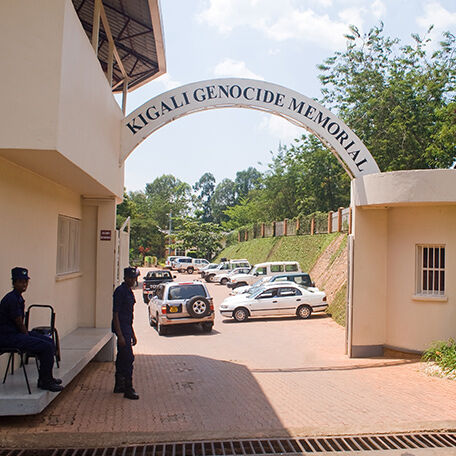
Below left: At a memorial site, clothes collected from genocide victims. Right: A memorial service to honor those who suffered.
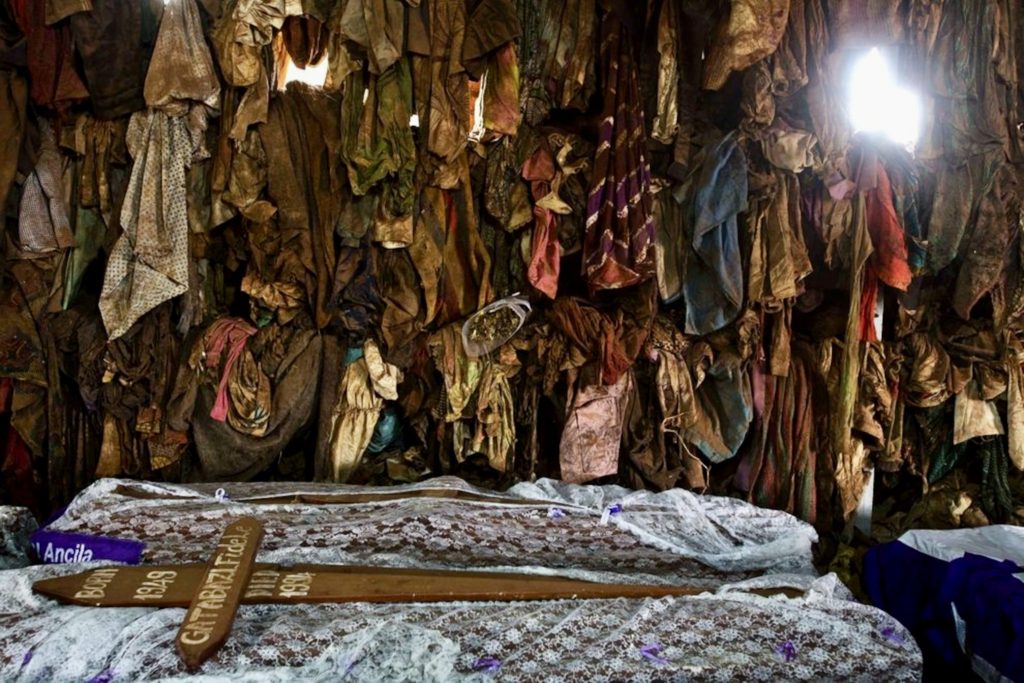

Rwanda has properly consecrated the suffering of the innocents in both public and private arenas. The private events include such things as reconciliations and interventions. Victims spoke to me of neighborhood palavers (traditional neighborhood meetings) where the survivors confronted their family killers. In many cases, the victims forgave the executioners for the murders of their relatives. Survivors told me they accepted the apology and remorse of the killers. They are at peace with this situation and those who murdered their family. I have little idea what those mental and emotional processes would look like. In truth, reconciliation is the best result possible, post-genocide. I suppose if I walked in the shoes of the survivors, I could forgive people who murdered my relatives in cold blood. But boy, no matter how much I think about it, I have trouble getting to that spot of sweet forgiveness.
In contrast, public consecrations include:


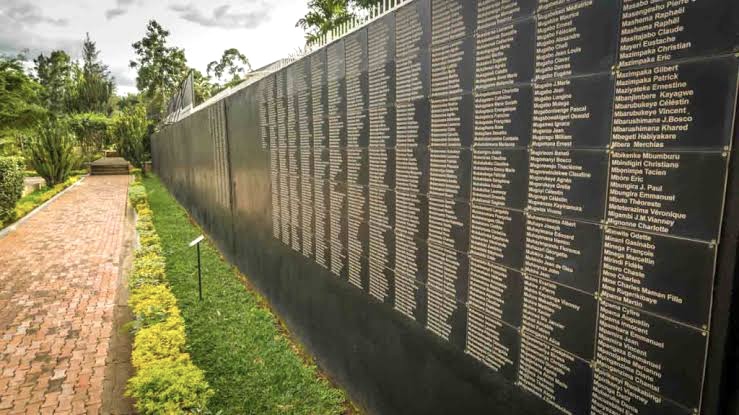
Personal Note: Many African adventurers and lucky tourists will rave about Rwanda as an under appreciated gem of a destination. How true. Traveling to Rwanda is a great escape for anyone with a sense of adventure, appreciation of either urban architecture or lush jungles, African history, natural beauty, or just lovely, kind people. Rwanda has “great energy” as they say; it is a country on the move. Rwanda today is a success story; an experience made joyous in light of its recent troubled past. My whole world-view changed as a result of my Rwanda experience. I will forever be an optimist about the future as I lived to see two pivotal world events. The first was collapse of the Berlin War, signaling the end of the Soviet Union. The second is the rebirth of Rwanda as a peaceful county with a hopeful future. As the Rwanda locals say: sawa sawa. It’s all good.
The Rwanda redemption story does not have to be unique. Other peoples, cultures and countries can learn from the Rwanda model. May all regions torn by strife succeed like Rwanda did — but hopefully have such transformative experiences that will avoid such horrors from ever happening. The best lesson is to overcome seemingly insurmountable hatred and divisions BEFORE descending into chaos and bloodshed.
Apology: I write about the struggles and joys of the Rwandan people. I never even got to write about the main destination gems:
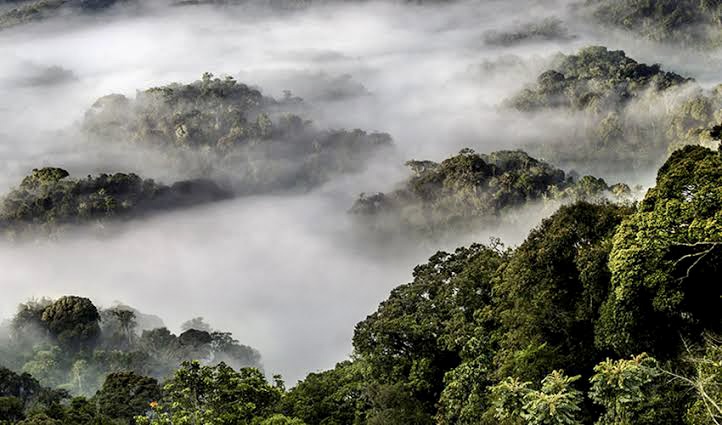
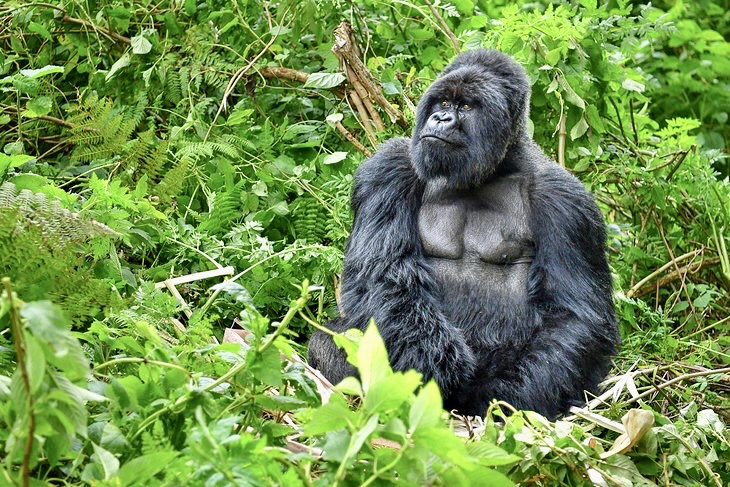

BONUS PHOTOS: The Beauty and Grace of Rwanda Woman.
Left: The woman in red was my tour guide at the Kigali zoo. We are looking at a crocodile exhibit just to the right of this picture. Right: The crocodile we are looking at.
Painting Below: A detail from “Four Avenga Women” by Helen Wilson. AVENGA is an organization of Rwandan women who became genocide widows. AVENGA works to improve the lives of those who lost their husbands.
Below: As mentioned, here is that crocodile my tour guide in red and I were looking at:

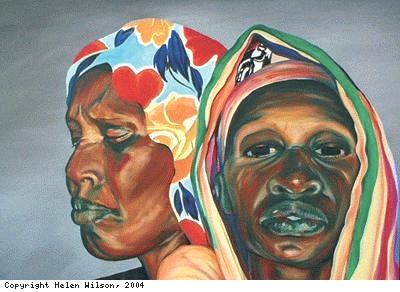
Post Script: Not All is Rosy in Rwanda. “Power Tends to Corrupt, and Absolute Power Corrupts Absolutely” Lord Acton
We don’t get enough good news in this world. This article celebrates human dignity and a complete victory over ignorance, greed, evil and worse. In the Rwandan Battle of Good vs. Evil — good won. This story, all of which is true, glosses over some wrinkles on the face of Rwanda justice. For example, the liberating soldiers of the RPF have been accused by some observers of human rights abuses against their Hutu adversaries. And those excesses are not much compared to Rwanda’s contemporary authoritarian government.
Nobody knows much about Lord Acton, except for his famous political science quote. Rwanda and Paul Kagame are the living embodiments of the truth as told by Lord Acton. Liberation leader and current President Paul Kagame has ruled Rwanda since 1994. He funneled down that easy path to become an authoritarian dictator. The Rwanda government moved on from an open, plural, multiparty democracy; and ran past the authoritarian, strong-man model; and is now sliding into an evil-dictator, dark hole. The most prominent example of the grotesque misuse of power swirls around Paul Rusesabagina, that “Hotel Rwanda” hero guy from the movie based on the true story. The movie is about the Rwanda Hutu hotel manager who hid all those Tutsi in his hotel and kept them alive. Once celebrated as a hero world-wide, Paul R. fell out of favor with his home government and he was living in self-imposed exile. In recent years, the Rwanda military kidnapped Paul R. and spirited him back to Rwanda for trial and prison. His crime? Criticizing the government of Paul Kagame. For the full story, see: https://en.m.wikipedia.org/wiki/Paul_Rusesabagina. Taken from the Wikipedia entry on Paul Rusesabagina: “The UN Working Group on Arbitrary Detentention rendered their opinion on 18 March 2022 that Rusesabagina had been illegally kidnapped, tortured, and sentenced after an unfair trial. The Working Group further found that Rusesabagina has been targeted by the Government on account of his work as a human rights defender, because of his criticism of the Government on a broad range of issues.”
Shameless Plug. Please consider signing up for a FREE subscription to this website which is both a travelogue and literary journal. Notices of new postings will be sent to readers by email. If interested, please, SUBSCRIBE BELOW. Note: Your information will never be marketed, sold, or used in any way. The marketing of personal data is a horrible idea. It will never happen to readers enjoying this website.
